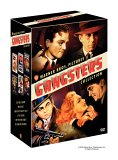Synopsis
This excellent survey of the Warner gangster films covers the peak of that genre’s popularity,and the earliest films in the set established two of the actors most closely associated with thegenre. First up is 1930’s Little Caesar, with Edward G. Robinson in the title role. Hot-tempered, violence prone Ccaesar Enrico (“Rico”) Bandello is tired of knocking over gasstations, and has his eye on the big time. The story follows his violent rise and fall and, as is trueof s… many of the films of this type, one is acutely aware of the social conditions that led createdRico.
This is even more true of James Cagney’s Tom Powers in The Public Enemy. Thetough kid on the make becomes the brutal, amoral thug. And while Jean Harlow is anembarrassing moll, Cagney’s ferocious energy burns up the screen, and the ending has lost noneof its power to shock.
The Petrified Forest (1936) is the film that has aged the least gracefully. The set-up(gangsters take innocents hostage in a remote location, match wills with disillusioned hero) issimilar to the later, and infinitely superior, Key Largo. Here, Humphrey Bogart launcheshis movie career as gangster Duke Mantee. He was still some years away from stardom, however,and he is very much a supporting player in this and the other films in this series. The proagonistis Leslie Howard, who is tired of life for no discernible reason other than being a member of theLost Generation. His passion revives when he encounters a young Bette Davis in the desert pitstop, but even his growing love for her doesn’t prevent him from being a motormouthed,pretentious, condescending twit. The film’s stage origins are also painfully obvious.
Cagney is back in Angels with Dirty Faces. He and best friend Pat O’Brien have gonedown different paths after a childhood theft. Cagney, who was caught and sent to a reformatory,becomes a gangster. O’Brien, who escaped, becomes a priest. (The implications here arefascinating.) When Cagney returns to his old neighbourhood, he becomes a hero to the Dead EndKids, while O’Brien tries to save them from a life of crime. Working against Cagney is formerpartner and devious lawyer Bogart. Cagney is in full charming rogue here, with Bogie theunmitigated swine.
That character pattern also holds true for The Roaring Twenties (1939). Completewith hectoring narrator, this sees Cagney return from the WWI to find no work for him, andgradually falls into the rackets. Bogart is the stone-cold killer who cannot be trusted, and PrsicillaLane is the nauseating goody-two-shoes Cagney falls for. This film comes at the end of thegangster cycle, and is the last time Cagney would play a gangster for ten years. But one hell ofa coda awaits.
Cagney as Tom Powers might be dangerous, but Cagney as Cody Jarrett in WhiteHeat (1949) is utterly psychopathic. Rarely has a film been more aptly titled, and Jarrett,obsessed with his mother and volcanically destructive, is one of the most terrifying gangstersever to stalk the screen. The suspense is excruciating, and the film wraps up this collection withone of the most famous (and literal) bangs in all of cinema.
Audio
No messing around with stereo remixes anywhere here. It’s the original mono all the way.The later the film, the cleaner the sound. Little Caesar ha some noticeable hiss and static,and there’s some distortion on the dialogue in The Public Enemy, but their soundquality is still pretty damn good for movies coming so early in the sound era.
Video
The prints are, generally in very fine shape. There is some damage here and there (but verylittle), and some shots grainier than others. This is particularly the case with the earlier films, butremains true of the entire set. Still, the black-and-white tones are glorious, and the images arevery sharp.
Special Features
Each disc has commentary by a film scholar, and all the talks are enormously informative(though Drew Casper on White Heat sounds a bit awkward). There’s a featurette for eachfilm, and then there’s Warner Night at the Movies. Leonard Maltin sets the stage, and whatfollows are a trailer from the period, a newsreel, a short feature, and a cartoon. As one makesone’s way through the set, one gets a real snapshot of what going to the movies was like in thatdecade. Re-release forwards accompany Little Caesar and The Public Enemy,and there are the radio adaptations of The Petrified Forest and Angels with DirtyFaces. The menu’s have animated or scored main menus.
Closing Thoughts
This is one hell of a package. All of the films are worth seeing, and most are classics of thefirst water. The extras are a solid bunch, too. As a survey of the gangster film, I suppose thiscould be topped, but only with difficulty.
Special Features List
- Audio Commentaries
- Featurettes
- Short Features
- Trailers
- Cartoons
- Leornard Maltin Introductions
- Radio Adaptations
- Re-Release Forwards






